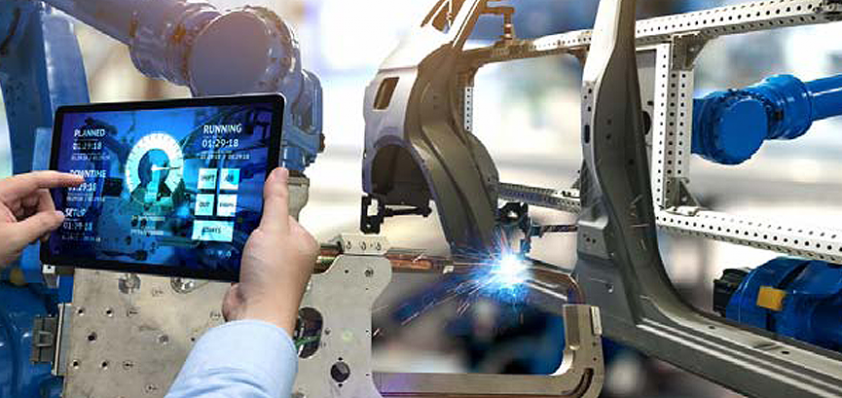
Join the collective
There are a lot of companies talking about Industry 4.0 right now. Yet this topic is nothing new. Industry 4.0 is defined as ‘the current trend of automation and data exchange in manufacturing technologies’. However, this leads to the question of does this really breakdown exactly what it means for consumers and the manufacturing industry?
I believe one of the main problems is that the term Industry 4.0 is too broad a term and means something different to everyone – Is it big data, AI or sensor networks? Although all these technologies are part of Industry 4.0, it is the results that are more important. What advantages does the evolution into Industry 4.0 bring? To that end, we can look at two approaches.
New factory concepts
The term ‘NEAR’ stands for Networked, Effective, Agile, and Responsible. For producers, having a ‘NEAR’ factory means improved productivity in response to ever-changing market demands. Nowadays production demands flexibility to adapt to changing market demands.
In a networked factory, there is better connection between machines in a manufacturing line for improved control and efficiency. The data and even control of the line can also be managed from anywhere in the world. And the system can draw on other data, such as market forecasts, to efficiently manage production schedules.
An effective factory is one with a high Overall Equipment Efficiency (OEE). Even today, outside of the automotive industry, which has a high OEE of 80 per cent or more, many production lines still struggle to break 50 per cent OEE due to line stoppages or other issues.
Raising OEE by even just a single per cent can deliver large gains to a company. Smart, interconnected systems can detect and monitor potential issues to help increase efficiency.
Manufacturers are also in need of more agile solutions, capable of changing production quickly without significant retooling in order to produce different variants or even different products to meet changing markets demands.
And finally, producers have a growing responsibility, whether it is an environmental one in terms of efficient use of raw materials, or a contractual one to deliver the right products, at the right time, and in the right quantity.
i-Automation!
‘i-Automation!’ explains the implementation for the ‘NEAR’ Factory concept, transforming the elements of Industry 4.0 into real benefits for machine makers. In some way, ‘i-Automation!’ sums up the value provided for improving manufacturing sites by focusing on three principles: ‘Integration, Intelligence and Interactive’.
Integration is about increasing the precision and speed of the production process through fine-tuned technology and control systems. Ensuring that all the machines in a production line can communicate with each other and operate seamlessly, helping to boost efficiency and keep the line running to optimal efficiency.
Interactive explains the challenge faced by many companies in finding and retaining skilled operators. That means machines need to be intuitive and easy-to-operate, even for less skilled operators. They need to present clear information about machine or system status, highlighting when a parameter is out of range or a process is not working efficiently, and ideally showing what needs to be done to correct it.
Machine intelligence, for a machine to be able to make smart decisions, it needs sensors to detect and monitor its operating environment and rules on how to respond to any changes. The more data there is, and the more processing is performed, the ‘smarter’ the machine can be.
Individual systems
The main differentiation between manufacturing lines and other ‘connected’ applications, such as cars, is that each production line is unique.
In manufacturing, each production line is a unique system composed of a variation of different pieces of machinery. Each machine may have multiple different sensors all feeding data to one central control system, or even into the cloud. The challenge is how to make sense of all that data.
Providing this type of analysis and control requires highly advanced algorithms that can adapt to each individual line. More importantly, these algorithms also need to be installed locally on the machine to give the machines the ability to learn each process and determine optimal operating conditions and provide appropriate warnings.
What benefits will this bring?
The evolution towards Industry 4.0 will not occur overnight, however the benefits that this brings will surely propel the adoption of the fourth industrial revolution. The cloud, AI algorithms and sensors need to be thought of as a collective when we talk about Industry 4.0, only when the elements are combined do the benefits become prevalent.
Lucian Dold
Lucian Dold is General Channel & Product Marketing Manager at Omron Europe. OMRON Corporation is a global leader in the field of automation based on its core technology of ‘Sensing & Control + Think’. OMRON’s business fields cover a broad spectrum, ranging from industrial automation and electronic components to automotive electronic components, social infrastructure systems, healthcare, and environmental solutions.
www.omron.com